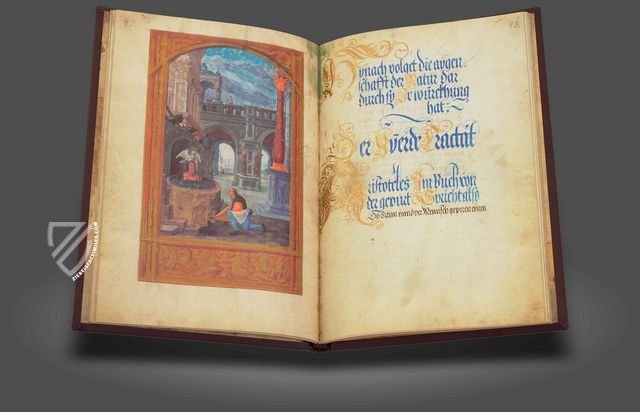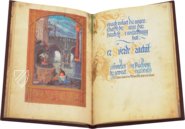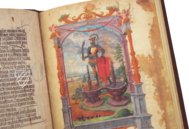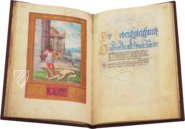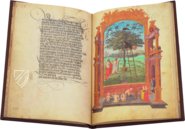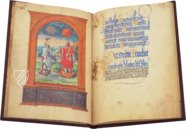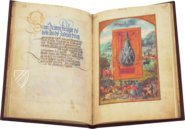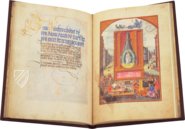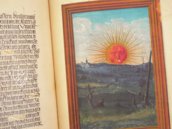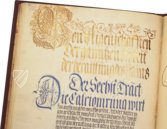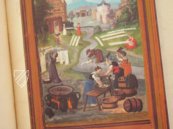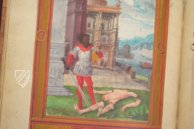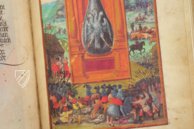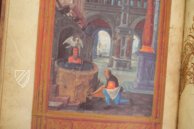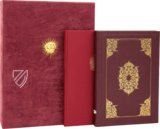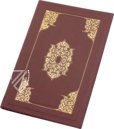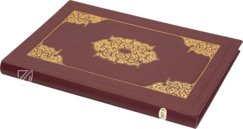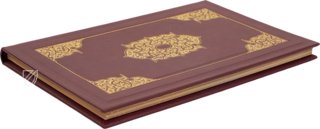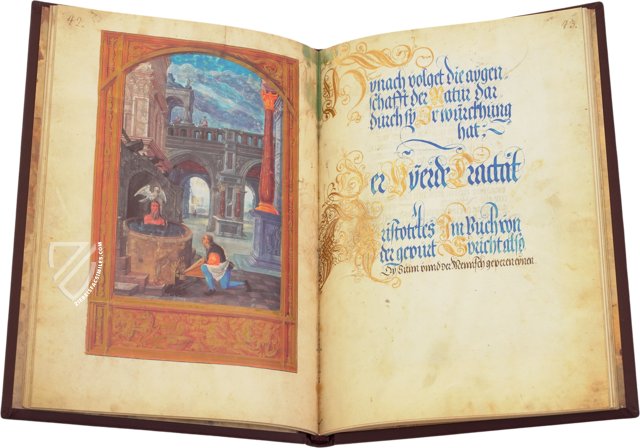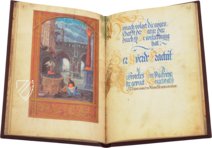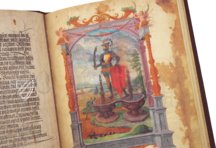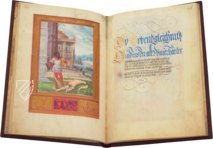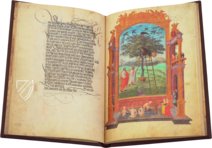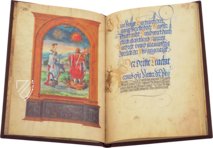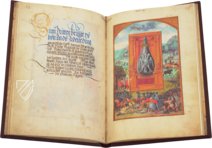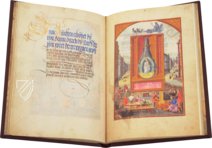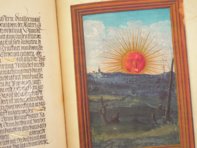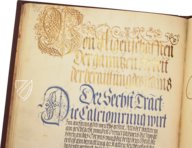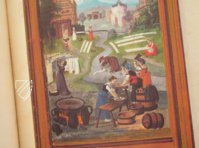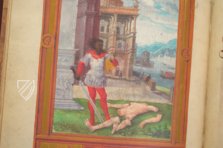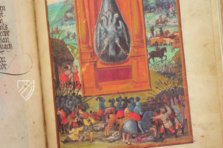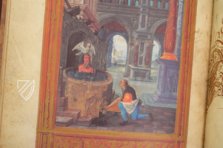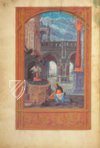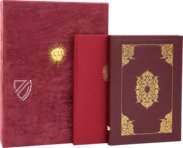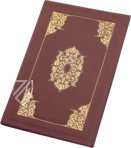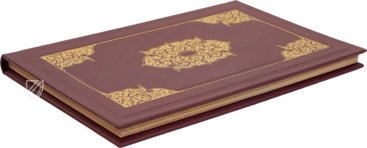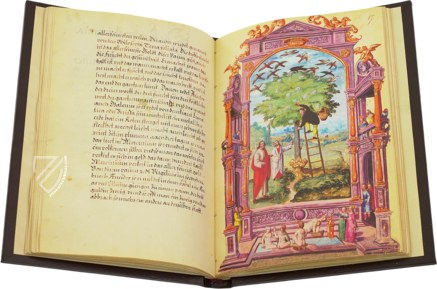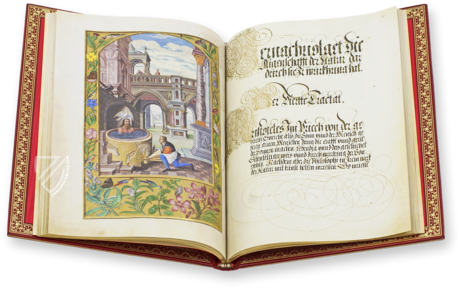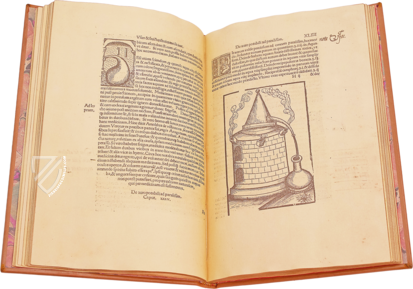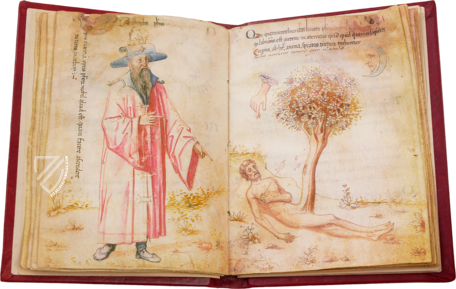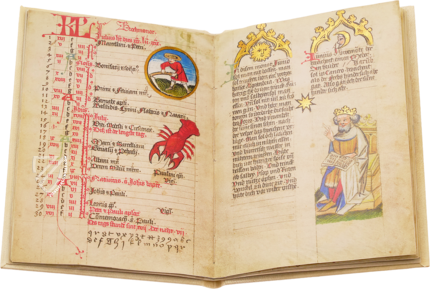Splendor Solis - Sonnenglanz
(1,000€ - 3,000€)
The codex in Berlin known as the Splendor Solis – Sonnenglanz manuscript is the oldest surviving specimen on the basic teachings of alchemy and one of the most beautiful 16th century German manuscripts in existence. Although the artist’s identity remains a matter of debate among researchers, its artistry is truly masterful and the manuscript is believed to have been made for a member of the wealthy and powerful Fugger family of Augsburg. The artist managed to create an image program of incredible perfection, made all the more impressive by the challenge of illustrating such a vague and esoteric text. This manuscript was copied many times by trusted associates of the family who admired its artistry and wanted to possess its secret knowledge.
Splendor Solis – Sonnenglanz
How does one make gold from any substance? What is the philosopher’s stone and how does one manufacture it? And how can one also ennoble one’s soul in the process? These and other questions of alchemy are answered by the manuscript dated to 1531/2, which was probably made for the Fugger family in Augsburg and which is now stored in the Museum of Prints and Drawings in Berlin. This manuscript of the Splendor Solis is counted among the most beautiful German works of the 16th century. It is an important alchemical treatise written at the dawn of modern science accompanied by a series of elaborate images set in ornamental borders and niches similar in style to the decorative borders used in contemporary books of hours. The manuscript’s symbolic process follows the alchemical death and rebirth of a king, followed by a series of 7 flasks, each associated with one of the planets. Within the flasks a process is shown involving the transformation of bird and animal symbols into the Queen and King, represented by white and red pigment.
The Tenets of Alchemy
The richly illuminated luxury manuscript is the oldest surviving specimen of the basic teachings of alchemy. On the one hand, it is concerned with finding philosopher’s stone and the key to the changing and refinement of matter therewith, on the other hand, the profane pursuit of wealth and power plays a considerable role: the production of gold. Typical alchemical processes were described and congenially illustrated in full-page miniatures. The illuminator had the task of translating the descriptions in the treatise, which are not always easily comprehensible and often vague, in clear illustrations and pictorial narrative. In doing so, the unusual theme required a high degree of creative intelligence.
Jörg Breu the Elder or Albrecht Glockendon?
The illuminator, whose identity remains contested to this day, must have interlinked his own world of imagery oriented on Christian and mythological art with the profane alchemical text, which he realized in seldom-achieved perfection. A comprehensive stock of motifs served his new inventions and compilations, which were drawn from extremely diverse contexts. In addition to older illuminated alchemical tracts, from which he was able to extract subject-specific hieroglyphics, he primarily had contemporary printmaking to draw on as a repertory.
Repeatedly Copied and All Over the World Today
Due to its fascinating theme and the quality of its miniatures, the Splendor Solis was already copied by hand many times and as such, ca. 20 manuscripts of this treaty are in existence. Aside from the Berlin specimen (the oldest), there are also a copies in the British Library in London, the Spanish National Library in Madrid, and the Bibliothèque nationale de France in Paris. Nevertheless, it was no “bestseller” in the true sense of the word for a simple reason: the original manuscript was not sold by its owner for gold, but rather was only lent to high-ranking persons to allow them to copy it.
Codicology
- Alternative Titles
- The Splendor of the Sun
Sonnenglanz - Size / Format
- 80 pages / 33.1 × 22.8 cm
- Origin
- Germany
- Date
- Ca. 1531–1532
- Epochs
- Style
- Language
- Illustrations
- 19 full-page miniatures, 43 headlines and initials in gold
- Content
- Treatise on alchemy with a symbolic process tracing the alchemical death and rebirth of a king followed by a series of 7 flasks, each associated with one of the planets.
- Artist / School
- Probably Jörg Breu the Elder (1475–1537), of Augsburg (illuminator)
Probably Albrecht Glockendon the Younger (1500–1545) (illuminator)
School of Nuremberg - Previous Owners
- Rodolphe Hirsch Kann (1845–1905)
Splendor Solis - Sonnenglanz
A Bathing Alchemist
Like most alchemical manuscripts, this German Renaissance work is filled with allegorical imagery in order to guard alchemy’s secrets from the uninitiated. An attendant fans the flames of a large brick bath wherein a bearded man is seated with a white dove on his head symbolizing the cleansing of the soul. The scene is a metaphor for the albedo, a stage of purification for both substances and for the purification of one’s soul to restore it to its original state of purity and receptivity.
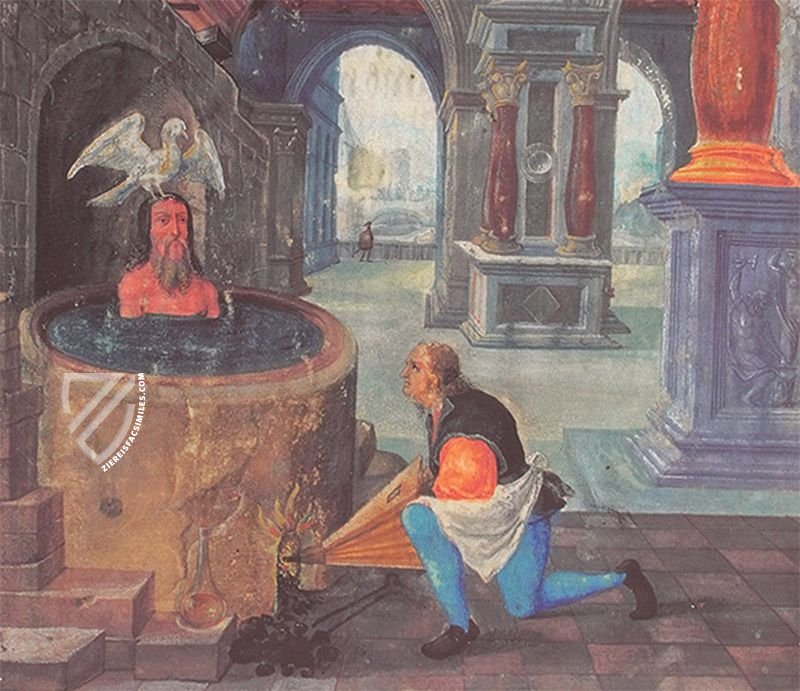
Splendor Solis - Sonnenglanz
Severing the Head of the King
Like the rest of the miniatures in this manuscript, this gruesome but masterfully painted scene is contained within a splendid frame reminiscent of a book of hours. These 22 scenes represent the classical alchemical death and rebirth of the king, including a series of seven flasks representing the planets of our solar system. This is the beginning of this symbolic process.
A decapitated and dismembered body is laying at the feet of a dark-skinned soldier, possibly a Turk, who is dressed in classically-styled armor. He holds an Italian longsword in one hand and the golden head of the king in the other. The violence of this scene is partially mitigated by its gorgeous setting with classical architectures, boaters on the river, and towering mountains in the distance.
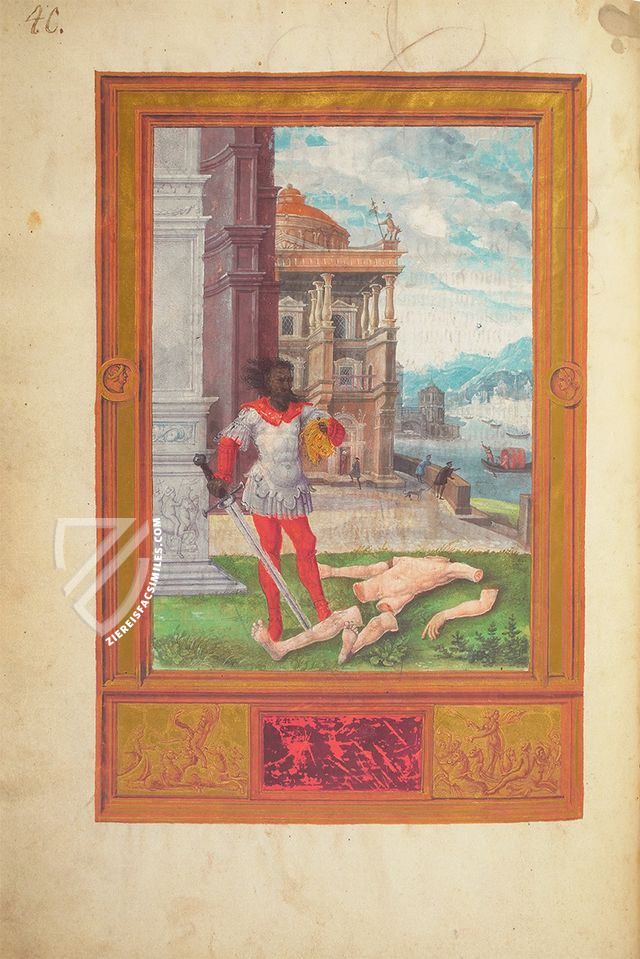
#1 Splendor Solis - Sonnenglanz
Language: German
(1,000€ - 3,000€)
- Treatises / Secular Books
- Apocalypses / Beatus
- Astronomy / Astrology
- Bestiaries
- Bibles / Gospels
- Chronicles / History / Law
- Geography / Maps
- Saints' Lives
- Islam / Oriental
- Judaism / Hebrew
- Single Leaf Collections
- Leonardo da Vinci
- Literature / Poetry
- Liturgical Manuscripts
- Medicine / Botany / Alchemy
- Music
- Mythology / Prophecies
- Psalters
- Other Religious Books
- Games / Hunting
- Private Devotion Books
- Other Genres
- Afghanistan
- Armenia
- Austria
- Belgium
- Belize
- Bosnia and Herzegovina
- China
- Colombia
- Costa Rica
- Croatia
- Cyprus
- Czech Republic
- Denmark
- Egypt
- El Salvador
- Ethiopia
- France
- Germany
- Greece
- Guatemala
- Honduras
- Hungary
- India
- Iran
- Iraq
- Israel
- Italy
- Japan
- Jordan
- Kazakhstan
- Kyrgyzstan
- Lebanon
- Liechtenstein
- Luxembourg
- Mexico
- Morocco
- Netherlands
- Palestine
- Panama
- Peru
- Poland
- Portugal
- Romania
- Russia
- Serbia
- Spain
- Sri Lanka
- Sweden
- Switzerland
- Syria
- Tajikistan
- Turkey
- Turkmenistan
- Ukraine
- United Kingdom
- United States
- Uzbekistan
- Vatican City
- A. Oosthoek, van Holkema & Warendorf
- Aboca Museum
- Ajuntament de Valencia
- Akademie Verlag
- Akademische Druck- u. Verlagsanstalt (ADEVA)
- Aldo Ausilio Editore - Bottega d’Erasmo
- Alecto Historical Editions
- Alkuin Verlag
- Almqvist & Wiksell
- Amilcare Pizzi
- Andreas & Andreas Verlagsbuchhandlung
- Archa 90
- Archiv Verlag
- Archivi Edizioni
- Arnold Verlag
- ARS
- Ars Magna
- ArtCodex
- AyN Ediciones
- Azimuth Editions
- Badenia Verlag
- Bärenreiter-Verlag
- Belser Verlag
- Belser Verlag / WK Wertkontor
- Benziger Verlag
- Bernardinum Wydawnictwo
- BiblioGemma
- Biblioteca Apostolica Vaticana (Vaticanstadt, Vaticanstadt)
- Bibliotheca Palatina Faksimile Verlag
- Bibliotheca Rara
- Boydell & Brewer
- Bramante Edizioni
- Bredius Genootschap
- Brepols Publishers
- British Library
- C. Weckesser
- Caixa Catalunya
- Canesi
- CAPSA, Ars Scriptoria
- Caratzas Brothers, Publishers
- Carus Verlag
- Casamassima Libri
- Centrum Cartographie Verlag GmbH
- Chavane Verlag
- Christian Brandstätter Verlag
- Circulo Cientifico
- Club Bibliófilo Versol
- Club du Livre
- CM Editores
- Collegium Graphicum
- Collezione Apocrifa Da Vinci
- Comissão Nacional para as Comemorações dos Descobrimentos Portugueses
- Coron Verlag
- Corvina
- CTHS
- D. S. Brewer
- Damon
- De Agostini/UTET
- De Nederlandsche Boekhandel
- De Schutter
- Deuschle & Stemmle
- Deutscher Verlag für Kunstwissenschaft
- DIAMM
- Droz
- E. Schreiber Graphische Kunstanstalten
- Ediciones Boreal
- Ediciones Grial
- Ediclube
- Edições Inapa
- Edilan
- Editalia
- Edition Deuschle
- Edition Georg Popp
- Edition Leipzig
- Edition Libri Illustri
- Editiones Reales Sitios S. L.
- Éditions de l'Oiseau Lyre
- Editions Medicina Rara
- Editorial Casariego
- Editorial Mintzoa
- Editrice Antenore
- Editrice Velar
- Edizioni Edison
- Egeria, S.L.
- Eikon Editores
- Electa
- Emery Walker Limited
- Enciclopèdia Catalana
- Eos-Verlag
- Ephesus Publishing
- Ernst Battenberg
- Eugrammia Press
- Extraordinary Editions
- Fackelverlag
- Facsimila Art & Edition
- Facsimile Editions Ltd.
- Facsimilia Art & Edition Ebert KG
- Faksimile Verlag
- Feuermann Verlag
- Folger Shakespeare Library
- Franco Cosimo Panini Editore
- Friedrich Wittig Verlag
- Fundación Hullera Vasco-Leonesa
- G. Braziller
- Gabriele Mazzotta Editore
- Gebr. Mann Verlag
- Gesellschaft für graphische Industrie
- Getty Research Institute
- Giovanni Domenico de Rossi
- Giunti Editore
- Graffiti
- Grafica European Center of Fine Arts
- Guido Pressler
- Guillermo Blazquez
- Gustav Kiepenheuer
- H. N. Abrams
- Harrassowitz
- Harvard University Press
- Helikon
- Hendrickson Publishers
- Henning Oppermann
- Herder Verlag
- Hes & De Graaf Publishers
- Hoepli
- Holbein-Verlag
- Houghton Library
- Hugo Schmidt Verlag
- Idion Verlag
- Il Bulino, edizioni d'arte
- ILte
- Imago
- Insel Verlag
- Insel-Verlag Anton Kippenberger
- Instituto de Estudios Altoaragoneses
- Instituto Nacional de Antropología e Historia
- Istituto dell'Enciclopedia Italiana - Treccani
- Istituto Ellenico di Studi Bizantini e Postbizantini
- Istituto Geografico De Agostini
- Istituto Poligrafico e Zecca dello Stato
- Italarte Art Establishments
- Jan Thorbecke Verlag
- Johnson Reprint Corporation
- Josef Stocker
- Josef Stocker-Schmid
- Jugoslavija
- Karl W. Hiersemann
- Kasper Straube
- Kaydeda Ediciones
- Kindler Verlag / Coron Verlag
- Kodansha International Ltd.
- Konrad Kölbl Verlag
- Kurt Wolff Verlag
- La Liberia dello Stato
- La Linea Editrice
- La Meta Editore
- Lambert Schneider
- Landeskreditbank Baden-Württemberg
- Leo S. Olschki
- Les Incunables
- Liber Artis
- Library of Congress
- Libreria Musicale Italiana
- Lichtdruck
- Lito Immagine Editore
- Lumen Artis
- Lund Humphries
- M. Moleiro Editor
- Maison des Sciences de l'homme et de la société de Poitiers
- Manuscriptum
- Martinus Nijhoff
- Maruzen-Yushodo Co. Ltd.
- MASA
- Massada Publishers
- McGraw-Hill
- Metropolitan Museum of Art
- Militos
- Millennium Liber
- Müller & Schindler
- Nahar - Stavit
- Nahar and Steimatzky
- National Library of Wales
- Neri Pozza
- Nova Charta
- Oceanum Verlag
- Odeon
- Orbis Mediaevalis
- Orbis Pictus
- Österreichische Staatsdruckerei
- Oxford University Press
- Pageant Books
- Parzellers Buchverlag
- Patrimonio Ediciones
- Pattloch Verlag
- PIAF
- Pieper Verlag
- Plon-Nourrit et cie
- Poligrafiche Bolis
- Presses Universitaires de Strasbourg
- Prestel Verlag
- Princeton University Press
- Prisma Verlag
- Priuli & Verlucca, editori
- Pro Sport Verlag
- Propyläen Verlag
- Pytheas Books
- Quaternio Verlag Luzern
- Reales Sitios
- Recht-Verlag
- Reichert Verlag
- Reichsdruckerei
- Reprint Verlag
- Riehn & Reusch
- Roberto Vattori Editore
- Rosenkilde and Bagger
- Roxburghe Club
- Salerno Editrice
- Saltellus Press
- Sandoz
- Sarajevo Svjetlost
- Schöck ArtPrint Kft.
- Schulsinger Brothers
- Scolar Press
- Scrinium
- Scripta Maneant
- Scriptorium
- Shazar
- Siloé, arte y bibliofilia
- SISMEL - Edizioni del Galluzzo
- Sociedad Mexicana de Antropología
- Société des Bibliophiles & Iconophiles de Belgique
- Soncin Publishing
- Sorli Ediciones
- Stainer and Bell
- Studer
- Styria Verlag
- Sumptibus Pragopress
- Szegedi Tudomànyegyetem
- Taberna Libraria
- Tarshish Books
- Taschen
- Tempus Libri
- Testimonio Compañía Editorial
- Thames and Hudson
- The Clear Vue Publishing Partnership Limited
- The Facsimile Codex
- The Folio Society
- The Marquess of Normanby
- The Richard III and Yorkist History Trust
- Tip.Le.Co
- TouchArt
- TREC Publishing House
- TRI Publishing Co.
- Trident Editore
- Tuliba Collection
- Typis Regiae Officinae Polygraphicae
- Union Verlag Berlin
- Universidad de Granada
- University of California Press
- University of Chicago Press
- Urs Graf
- Vallecchi
- Van Wijnen
- VCH, Acta Humaniora
- VDI Verlag
- VEB Deutscher Verlag für Musik
- Verlag Anton Pustet / Andreas Verlag
- Verlag Bibliophile Drucke Josef Stocker
- Verlag der Münchner Drucke
- Verlag für Regionalgeschichte
- Verlag Styria
- Vicent Garcia Editores
- W. Turnowski Ltd.
- W. Turnowsky
- Waanders Printers
- Wiener Mechitharisten-Congregation (Wien, Österreich)
- Wissenschaftliche Buchgesellschaft
- Wissenschaftliche Verlagsgesellschaft
- Wydawnictwo Dolnoslaskie
- Xuntanza Editorial
- Zakład Narodowy
- Zollikofer AG

